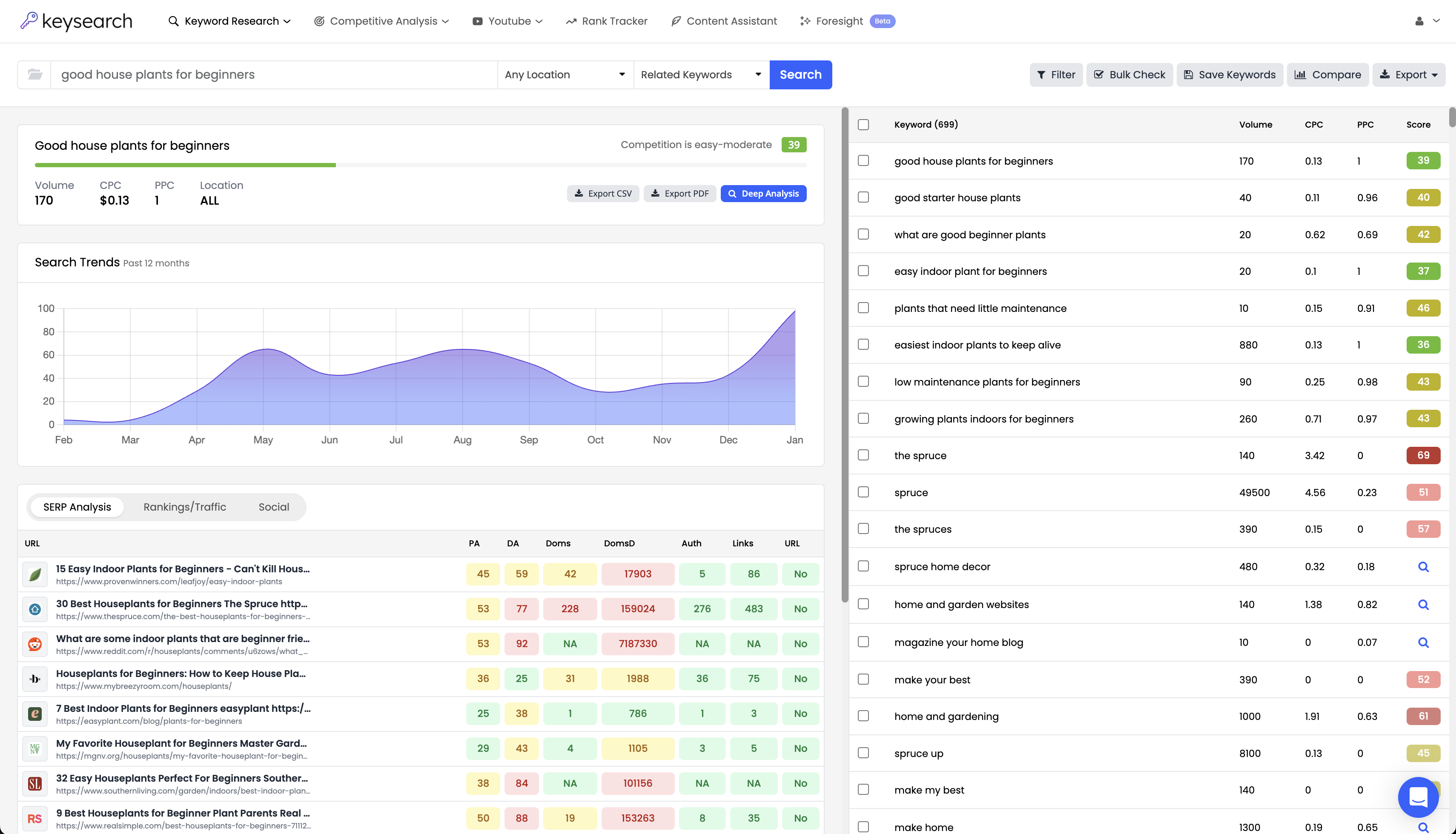So much of the emphasis is placed on keyword research when it comes to SEO, and for good reason. After all, this is the foundation of your strategy.
Without the right keywords, you don’t know how to optimize your pages – or, you could end up spinning your tires attempting to rank for irrelevant or overly difficult keywords.
Fortunately, keyword research is made easy with KeySearch, your comprehensive database for the best free SEO tools. From finding LSI keywords to long tail keywords, it’s never been easier or more affordable to uncover the top keywords for your niche.
All that being said – figuring out what to do after keyword research is just as important! Otherwise, it’s like mapping out your destination for a road trip only to realize you don’t have any gas in your car.
So, we’ve put together this quick guide to help you feel confident and clear in your next steps, which include:
- Organize keywords and prioritize opportunities
- Map keywords to specific pages that already exist
- Create new content or optimize old content to satisfy search intent
- Implement keyword tracking to gauge progress
- Build backlinks to boost authority
- Be patient while you wait for the traffic to roll in
The best part? KeySearch, being an all-in-one SEO powerhouse, can help you navigate each and every aspect of planning and executing your strategy, right down to content creation and rank tracking. Find out what makes it the #1 SEO toolkit today!
Keyword Research: The Foundation of Any Effective SEO Strategy
If you haven’t already done your keyword research, you’ll want to take a step back and narrow your focus on this task first. This is the process of identifying the words and phrases that people use in search engines when looking for information, products, or services.
Why it Matters
It is a fundamental component of any successful SEO strategy because it helps you understand your audience’s needs and optimize your content to meet those needs. It’s used for paid advertising as well, but that’s a conversation for another day. Here’s why effective keyword research is so important:
- Increases Visibility: Using the right keywords helps your content rank higher in search engine results pages (SERPs), making it easier for potential customers to find you.
- Drives Targeted Traffic: With increased visibility comes increased traffic. Not just any traffic, though – targeted traffic from users who are specifically looking for what you offer. This means it’s more likely to convert into customers or clients, providing a better ROI for your SEO efforts.
- Informs Content Strategy: Understanding what your audience is searching for empowers you to create content addressing their needs and questions. This not only improves your SEO but also enhances user satisfaction and engagement.
- Improves User Experience: Aligning content with the search intent of your audience provides them with valuable information that meets their needs. This leads to longer time spent on your site, lower bounce rates, and higher engagement metrics.
How to Do it
So, how do you do it? If you haven’t already gathered a list of relevant keywords, here’s a brief overview of the process – which can be streamlined through our offerings here at KeySearch:
- Brainstorm Seed Keywords: Think about the main topics you want to rank for and list out a few seed keywords. For example, if you run a bakery, seed keywords might include “fresh bread,” “artisan pastries,” and “gluten-free desserts.”
- Use Keyword Research Tools: KeySearch can help you expand your seed keywords into a comprehensive list. They provide data on search volume, competition, and related keywords, allowing you to find the best opportunities.
- Analyze Search Volume and Competition: The sweet spot for keywords is a high search volume but low to medium competition. These offer the best chance of ranking well in a timely manner. High search volume indicates demand, while low competition means fewer websites are trying to rank for those terms.
- Consider User Intent: Are users looking for information, trying to make a purchase, or seeking a specific service? Finding a high-volume, low-difficulty keyword is great – but if it’s not relevant to your product or service, what’s the point?
- Create Keyword Clusters: Group related keywords into clusters that can be targeted with individual pieces of content. This helps you cover a topic comprehensively and increases your chances of ranking for multiple related terms.
Whether you’re trying to do Amazon keyword research, Pinterest keyword research, Etsy keyword research, eBay keyword research, YouTube keyword research, or even just want to rank on Google, KeySearch has the tools you need for efficient, effective research.
What to Do After Keyword Research to Start Driving More Organic Traffic
So, what do I do with all my keywords after keyword research? The short answer is you simply prioritize opportunities then create content and gather backlinks accordingly. Simple enough, right?
That being said, we want to guide you through a comprehensive guide on what to do after keyword research so you can set yourself up for success and start reaping the fruits of your SEO efforts ASAP!
Organize Keywords and Prioritize Opportunities
So you’ve got a massive list of keywords – where do you even begin? Let’s start by creating some sort of order and organization to prevent information overload.
Group your keywords into relevant categories based on themes or topics. This helps create a structured approach to content creation and optimization. Our keyword clustering tool can streamline this process.
For example, if you have keywords related to “digital marketing,” group them into sub-categories like “SEO,” “social media marketing,” “content marketing,” “email marketing,” etc.
You can also break down keywords based on intent and where the user is in the funnel. To keep things simple, you can categorize your keywords based on whether they have buying intent or informational intent.
If you want to take things a step further, you can group keywords based on the purchasing funnel more specifically – be it top of the funnel (what is [keyword]), middle of the funnel (is [keyword] worth it?), and bottom of the funnel (best [keyword]).
Develop a matrix that includes all your keywords, their search volumes, competition levels, and relevance to your business. This matrix will serve as a roadmap for your SEO strategy. You can use a tool like KeySearch for this which has rank tracking built-in, or you can simply upload all this data to a Google Sheet.
In terms of prioritization, you’ll have to think logically about what makes the most sense for your business. Your domain authority will play a role here as well, as you need to think critically and rationally about what level of difficulty you’ll be able to rank for.
Our advice is to start with low-hanging fruit to get quick wins and build up domain authority. Use our keyword difficulty checker to find keywords with at least 100 searches a month and a difficulty score under 30.
Map Keywords to Specific Pages
Whether you’re building a website from scratch or optimizing an existing website, it’s important that you start mapping keywords to specific pages.
Use tools like Google Analytics to determine which pages are already performing well and which ones need improvement. From there, you can map your primary keywords to the most relevant pages on your site. These should be the main focus of each page.
Then, assign secondary keywords that are related to the primary keyword but have a slightly different focus. These can be used to support the primary keyword in the content.
We touched on searcher intent, and we’ll continue to do so here and later on. Because if you aren’t creating pages and content with searcher intent in mind, you’ll be treading water and never really see any rankings.
This is to say that buyer intent keywords should be mapped to collection/category pages or product pages. Meanwhile, informational intent keywords should probably be mapped to the blog.
Ensure that your keywords are naturally integrated into on-page elements such as titles, meta descriptions, headers, and body content. Avoid keyword stuffing – focus on providing value to the reader and maintaining readability. Our keyword density checker will come in handy for this step.
Organize Keywords and Prioritize Opportunities
So you’ve got a massive list of keywords – where do you even begin? Let’s start by creating some sort of order and organization to prevent information overload.
Group your keywords into relevant categories based on themes or topics. This helps create a structured approach to content creation and optimization. Our keyword clustering tool can streamline this process.
For example, if you have keywords related to “digital marketing,” group them into sub-categories like “SEO,” “social media marketing,” “content marketing,” “email marketing,” etc.
You can also break down keywords based on intent and where the user is in the funnel. To keep things simple, you can categorize your keywords based on whether they have buying intent or informational intent.
If you want to take things a step further, you can group keywords based on the purchasing funnel more specifically – be it top of the funnel (what is [keyword]), middle of the funnel (is [keyword] worth it?), and bottom of the funnel (best [keyword]).
Develop a matrix that includes all your keywords, their search volumes, competition levels, and relevance to your business. This matrix will serve as a roadmap for your SEO strategy. You can use a tool like KeySearch for this which has rank tracking built-in, or you can simply upload all this data to a Google Sheet.
In terms of prioritization, you’ll have to think logically about what makes the most sense for your business. Your domain authority will play a role here as well, as you need to think critically and rationally about what level of difficulty you’ll be able to rank for.
Our advice is to start with low-hanging fruit to get quick wins and build up domain authority. Use our keyword difficulty checker to find keywords with at least 100 searches a month and a difficulty score under 30.
Map Keywords to Specific Pages
Whether you’re building a website from scratch or optimizing an existing website, it’s important that you start mapping keywords to specific pages.
Use tools like Google Analytics to determine which pages are already performing well and which ones need improvement. From there, you can map your primary keywords to the most relevant pages on your site. These should be the main focus of each page.
Then, assign secondary keywords that are related to the primary keyword but have a slightly different focus. These can be used to support the primary keyword in the content.
We touched on searcher intent, and we’ll continue to do so here and later on. Because if you aren’t creating pages and content with searcher intent in mind, you’ll be treading water and never really see any rankings.
This is to say that buyer intent keywords should be mapped to collection/category pages or product pages. Meanwhile, informational intent keywords should probably be mapped to the blog.
Ensure that your keywords are naturally integrated into on-page elements such as titles, meta descriptions, headers, and body content. Avoid keyword stuffing – focus on providing value to the reader and maintaining readability. Our keyword density checker will come in handy for this step.
This is also a good time to use internal linking to connect related pages on your site. This not only helps with navigation but also distributes keyword relevance and authority across your website. Ensure that anchor texts for internal links include relevant keywords. Vary it up if you have secondary keywords you want to rank for, too.
Create New Content or Optimize Old Content to Satisfy Search Intent
Now comes the fun part of what to do after keyword research – content creation! Think back to search intent and determine what type of content you should be creating for each keyword. Is the user looking for information or are they closer to making a purchase?
The best way to know what type of content you should create is to plug your keyword into Google and see what pages are currently ranking for that query. If you see a lot of blog posts ranking, chances are, your product page isn’t going to rank. You’ll need to write a blog post.
On the other hand, if you find that Google is ranking bottom of the funnel pages like a collection page or a product page, you’ll want to create your own product page and fill it out with quality content that drives conversions.
There are so many great tools that can assist you with content creation in this day and age, you don’t have to be a copywriting expert to start implementing your strategy. Whether you write the content yourself and then optimize it with AI or start with AI and optimize it yourself, all that matters is:
- You’re meeting the searcher’s intent.
- You’re filling in the gaps left by competitors so your content stands out.
- You’re using keywords strategically – not stuffing them in – throughout the title, headings, and text.
- You’re prioritizing readability and delivering value for the searcher.
We have a suite of tools that can assist with your content creation efforts at KeySearch, from our duplicate content checker to our SEO content editor. Don’t work harder when you could work smarter!
If you are working on an existing site, your low-hanging fruit is going to be the pages that already exist. While you’ll definitely want to create new pages as well, split your resources and focus on optimizing existing content with your new list of keywords.
This might involve rewriting sections, adding new information, removing irrelevant sections to match search intent, or improving the overall quality of the content. You should also make sure you’re rethinking your internal linking strategy, updating metadata, and refreshing the posted date.
Implement structured data (schema markup) to help search engines understand the context of your content. This can improve your chances of appearing in rich snippets and other SERP features.
Implement Keyword Tracking to Gauge Progress
Use tools like Keysearch to track the rankings of your target keywords over time. Otherwise, how will you know how your efforts are paying off?
Monitor how your rankings improve as you implement your keyword strategy and see what’s working, and what isn’t. You can refine it accordingly. Set up alerts to notify you of significant changes in keyword rankings.
Regularly review your website’s analytics to assess the impact of your keyword strategy on traffic, bounce rates, and user engagement. Identify which keywords are driving the most traffic and which pages are performing best.
Don’t Forget the Role of Off-Page SEO!
You’ve probably heard that backlinks play a role in your SEO strategy – but you may not realize just how important they are. These are how you drive up the domain authority of your website. In other words, it’s how you compete for more difficult keywords and boost traffic.
There are many different ways you can go about acquiring backlinks – from simply finding a vendor and paying for them to guest posting. The specific strategy you employ will depend on your budget, time resources, and the relationships you’re able to forge with other websites.
It’s also a good idea to use social media platforms to promote your content and drive traffic to your website. Engaging with your audience on social media can also generate social signals that benefit SEO.
You can even collaborate with influencers in your niche to expand your reach and build credibility. This can help you tap into new audiences. Just ensure influencer partnerships are genuine and align with your brand values.
Give it Some Time
The most important takeaway from this guide on what to do after keyword research is this stuff takes time. SEO is a long-term strategy that won’t pay off for at least a few weeks, but more realistically, a few months.
That’s why it’s so important that you start putting these tips into practice ASAP. The longer you wait around, the longer it’ll be before you notice improvement in your organic rankings, and thus, the longer it’ll take to start seeing an impact on your bottom line.
Final Thoughts on What to Do After Keyword Research
There you have it – all your next steps after keyword research. Keyword research is the cornerstone of any effective SEO strategy, but it’s just the beginning.
After identifying your target keywords, organize and prioritize them, map them to existing pages, create or optimize content to match search intent, and track your progress.
Don’t overlook the importance of backlinking, and remember to be patient, as SEO results take time. By following these steps, you can boost organic traffic and achieve long-term success.
Now that you know what to do after keyword research, what are you waiting for? Whether you already have a database of keyword opportunities or you still need to find them, get started with KeySearch today.
It’s the #1 SEO toolkit for small bloggers and large-scale businesses alike. Don’t just take our word for it, though. See how it stacks up to the big names in the industry below:
With a 4.9 star rating across hundreds of reviews and 10,000+ active users relying on our solutions, you can rest assured you’re getting a reliable free SEO database. Take the first step to implementing a bulletproof SEO strategy today!
- How to Do Keyword Research for Free: Best Free Keyword Research Tools in 2024 - December 13, 2024
- Benefits of Keyword Clustering: Why is it Important to Group Relevant Keywords Together? - December 13, 2024
- What is Keyword Density in SEO and Its Importance - December 13, 2024







